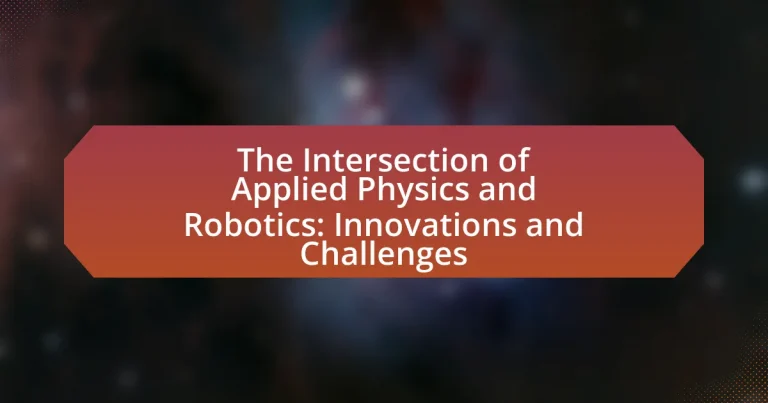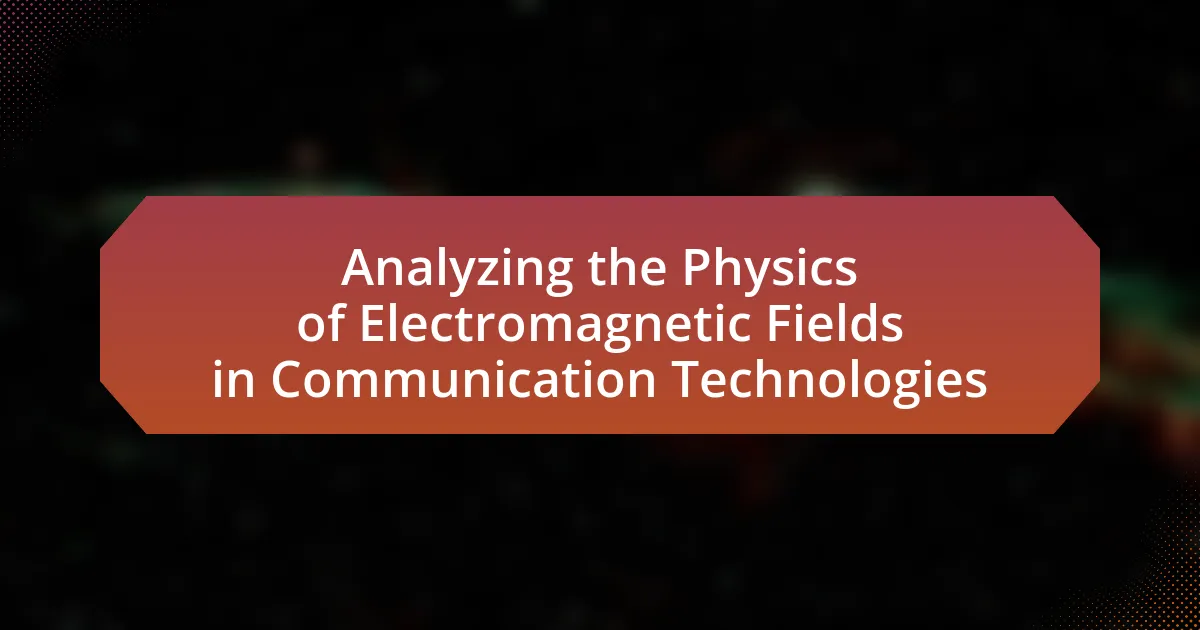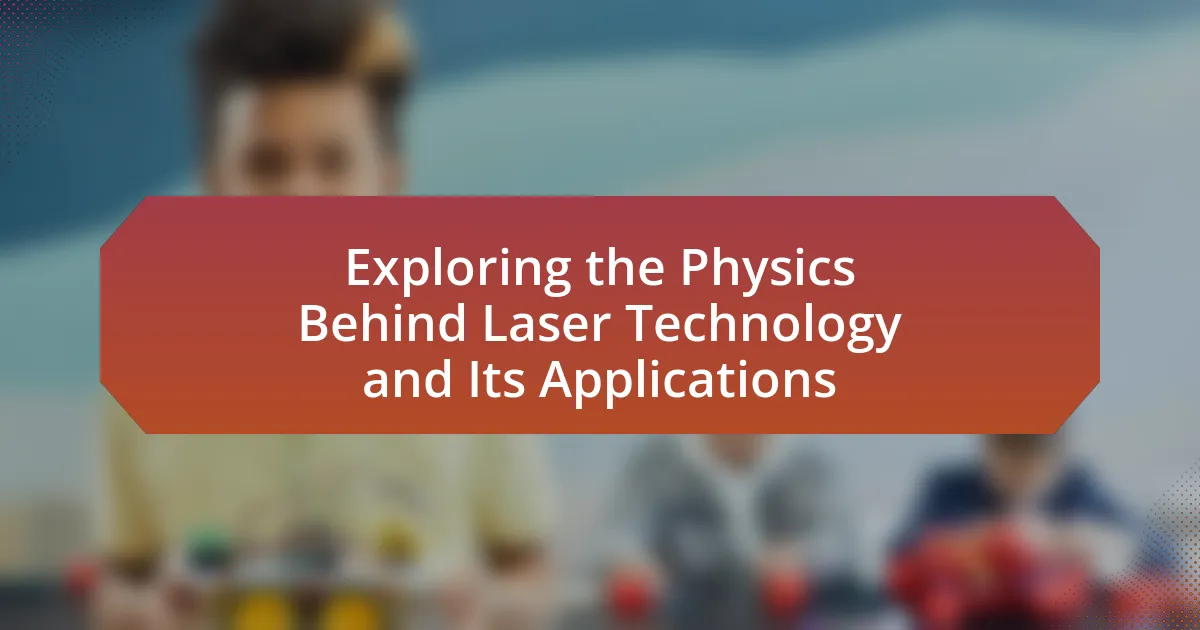The article explores the intersection of applied physics and robotics, highlighting how physical principles are applied to enhance robotic systems’ design, functionality, and efficiency. Key areas of focus include the essential principles of mechanics, electromagnetism, and control theory that underpin robotic operations, as well as innovations in materials science and sensor technology that drive advancements in the field. The article also addresses the challenges faced in integrating these disciplines, such as computational limitations and ethical considerations, while emphasizing the importance of interdisciplinary collaboration in overcoming these obstacles and fostering technological progress.

What is the Intersection of Applied Physics and Robotics?
The intersection of applied physics and robotics involves the application of physical principles to design, analyze, and improve robotic systems. Applied physics provides the foundational knowledge necessary for understanding the mechanics, dynamics, and control systems that govern robotic movement and functionality. For instance, concepts such as kinematics and dynamics are crucial for developing algorithms that enable robots to navigate and interact with their environments effectively. Additionally, advancements in materials science, a branch of applied physics, contribute to the development of lightweight and durable materials used in robotic construction, enhancing performance and efficiency. This integration of applied physics into robotics not only drives innovation but also addresses challenges such as energy efficiency and precision in robotic operations.
How do applied physics and robotics interact?
Applied physics and robotics interact through the application of physical principles to design and improve robotic systems. This interaction enables advancements in areas such as sensor technology, control systems, and materials science, which are essential for enhancing robot functionality and performance. For instance, the principles of mechanics and electromagnetism are crucial in developing actuators and sensors that allow robots to perceive and interact with their environment effectively. Additionally, applied physics contributes to the optimization of robotic movements and energy efficiency, as seen in the development of algorithms that mimic natural motion, improving the adaptability and efficiency of robots in various tasks.
What principles of applied physics are essential in robotics?
The essential principles of applied physics in robotics include mechanics, electromagnetism, thermodynamics, and control theory. Mechanics governs the movement and stability of robotic systems, allowing for the design of joints and limbs that can perform tasks effectively. Electromagnetism is crucial for the operation of sensors and actuators, enabling robots to interact with their environment. Thermodynamics plays a role in energy management and efficiency, particularly in power systems and thermal regulation of components. Control theory provides the mathematical framework for designing algorithms that enable robots to respond to sensory input and execute tasks autonomously. These principles are foundational for the development and functionality of robotic systems, as evidenced by their application in various robotic technologies, from industrial automation to autonomous vehicles.
How does robotics utilize concepts from applied physics?
Robotics utilizes concepts from applied physics by integrating principles such as mechanics, dynamics, and electromagnetism to design and control robotic systems. For instance, mechanics is essential for understanding the motion and forces acting on robots, enabling engineers to create efficient movement and stability in robotic limbs. Dynamics plays a crucial role in predicting how robots will respond to various forces, which is vital for tasks like navigation and manipulation. Additionally, electromagnetism is fundamental in the development of sensors and actuators that allow robots to interact with their environment. These applications demonstrate how robotics relies on applied physics to enhance functionality and performance, as evidenced by advancements in robotic arms that mimic human motion through precise control of mechanical joints and motors.
Why is the intersection important for technological advancement?
The intersection of applied physics and robotics is crucial for technological advancement because it enables the development of more efficient and capable robotic systems. This synergy allows for the application of physical principles to enhance robot design, control, and functionality, leading to innovations such as improved sensors, actuators, and algorithms. For instance, advancements in materials science, a branch of applied physics, have led to the creation of lighter and stronger materials for robotic structures, which directly impacts their performance and energy efficiency. Additionally, the integration of physics-based modeling in robotics facilitates better simulation and prediction of robotic behavior in complex environments, thereby accelerating the pace of innovation in the field.
What innovations have emerged from this intersection?
Innovations that have emerged from the intersection of applied physics and robotics include advanced robotic sensors, improved motion control systems, and enhanced materials for robotic construction. Advanced robotic sensors, such as LIDAR and computer vision systems, enable robots to perceive their environment with high precision, facilitating tasks like autonomous navigation and object recognition. Improved motion control systems, leveraging principles of applied physics, allow for more agile and responsive robotic movements, which are crucial in applications ranging from manufacturing to healthcare. Additionally, the development of lightweight, durable materials, such as carbon fiber composites, enhances the structural integrity and efficiency of robots, enabling them to perform complex tasks with greater energy efficiency. These innovations collectively advance the capabilities of robotics across various industries, demonstrating the significant impact of applied physics in this field.
How does this intersection influence future technologies?
The intersection of applied physics and robotics significantly influences future technologies by enabling the development of more advanced and efficient robotic systems. This synergy allows for the integration of principles from physics, such as mechanics and electromagnetism, into robotic design, leading to innovations like soft robotics and autonomous systems that can adapt to complex environments. For instance, advancements in materials science, a branch of applied physics, have led to the creation of lightweight, flexible materials that enhance robot mobility and functionality. Additionally, the application of physics in sensor technology improves the perception capabilities of robots, facilitating better interaction with their surroundings. These developments are evidenced by the increasing use of robotic systems in fields such as healthcare, manufacturing, and exploration, demonstrating the transformative impact of this intersection on future technological advancements.

What are the Key Innovations in Applied Physics and Robotics?
Key innovations in applied physics and robotics include advancements in materials science, artificial intelligence, and sensor technology. For instance, the development of metamaterials has enabled the creation of cloaking devices and improved imaging systems, enhancing robotic capabilities. Additionally, the integration of AI algorithms allows robots to learn from their environments and make autonomous decisions, significantly improving efficiency in tasks such as manufacturing and logistics. Furthermore, advancements in sensor technology, such as LiDAR and computer vision, have enhanced robots’ perception and navigation abilities, enabling them to operate safely in complex environments. These innovations are supported by research demonstrating their effectiveness, such as studies published in journals like “Nature” and “IEEE Transactions on Robotics,” which highlight the transformative impact of these technologies on robotics applications.
What recent breakthroughs have been made in this field?
Recent breakthroughs in the intersection of applied physics and robotics include advancements in soft robotics, particularly the development of materials that mimic biological systems. Researchers at Harvard University have created a soft robotic gripper that can adapt its shape to grasp delicate objects, utilizing a combination of flexible materials and advanced control algorithms. This innovation enhances the ability of robots to interact safely with fragile items, which is crucial for applications in fields such as healthcare and manufacturing. Additionally, a team from Stanford University has made strides in integrating quantum sensors into robotic systems, allowing for unprecedented precision in navigation and environmental sensing. These advancements demonstrate the potential for applied physics to significantly enhance robotic capabilities and applications.
How have these breakthroughs improved robotic functionality?
Breakthroughs in applied physics have significantly enhanced robotic functionality by enabling more precise control, improved sensory perception, and increased adaptability. For instance, advancements in materials science have led to the development of lightweight, durable materials that allow robots to operate more efficiently and with greater agility. Additionally, innovations in sensor technology, such as LiDAR and advanced cameras, have improved robots’ ability to perceive their environment, facilitating better navigation and obstacle avoidance. These enhancements are supported by data showing that robots equipped with advanced sensors can achieve up to 90% accuracy in object recognition tasks, compared to 70% in older models. Furthermore, breakthroughs in artificial intelligence algorithms have allowed robots to learn from their experiences, making them more adaptable to varying tasks and environments, which is evidenced by the increased deployment of robots in dynamic settings like warehouses and hospitals.
What role does simulation play in these innovations?
Simulation plays a crucial role in innovations at the intersection of applied physics and robotics by enabling the testing and optimization of robotic systems in virtual environments before physical implementation. This approach allows researchers and engineers to analyze complex interactions, predict system behaviors, and refine designs efficiently, reducing the risk of costly errors in real-world applications. For instance, simulations can model the dynamics of robotic movements, assess the impact of various physical forces, and evaluate the performance of algorithms under different scenarios, thereby enhancing the reliability and effectiveness of robotic technologies.
How are these innovations applied in real-world scenarios?
Innovations at the intersection of applied physics and robotics are applied in various real-world scenarios, such as autonomous vehicles, medical robotics, and industrial automation. For instance, autonomous vehicles utilize advanced sensor technologies and algorithms derived from applied physics to navigate and make real-time decisions, significantly enhancing road safety and efficiency. In the medical field, robotic surgical systems leverage precise physics-based models to perform minimally invasive procedures, improving patient outcomes and reducing recovery times. Additionally, industrial automation employs robotics powered by applied physics principles to optimize manufacturing processes, leading to increased productivity and reduced operational costs. These applications demonstrate the practical impact of integrating applied physics with robotics across multiple sectors.
What industries are most impacted by these advancements?
The industries most impacted by advancements in applied physics and robotics include manufacturing, healthcare, and transportation. In manufacturing, robotics enhances automation, leading to increased efficiency and reduced labor costs; for instance, the use of robotic arms in assembly lines has improved production rates significantly. In healthcare, robotics facilitates surgical procedures and patient care, exemplified by robotic-assisted surgeries that minimize recovery times and improve precision. In transportation, advancements in robotics contribute to the development of autonomous vehicles, which are projected to revolutionize logistics and personal transport by increasing safety and reducing traffic congestion. These industries demonstrate substantial transformations driven by the integration of applied physics and robotics technologies.
How do these innovations enhance efficiency and productivity?
Innovations in applied physics and robotics enhance efficiency and productivity by automating complex tasks and optimizing processes. For instance, robotic systems equipped with advanced sensors and algorithms can perform repetitive tasks with precision and speed, reducing human error and increasing output rates. According to a study by McKinsey, automation can boost productivity by up to 30% in various industries by streamlining workflows and minimizing downtime. Additionally, innovations such as machine learning enable robots to adapt to new tasks and environments, further enhancing their utility and effectiveness in diverse applications.

What Challenges Exist at the Intersection of Applied Physics and Robotics?
Challenges at the intersection of applied physics and robotics include the complexity of integrating advanced materials, the precision required in sensor technology, and the limitations of computational power for real-time processing. Advanced materials, such as smart materials and composites, pose challenges in terms of manufacturing and scalability, impacting the performance and durability of robotic systems. Precision in sensor technology is critical for tasks like navigation and manipulation, yet achieving the necessary accuracy and reliability remains difficult. Additionally, the computational power required for real-time data processing and decision-making in robotics often exceeds current capabilities, leading to delays and inefficiencies in robotic operations. These challenges highlight the need for ongoing research and innovation in both fields to enhance the functionality and effectiveness of robotic systems.
What are the primary technical challenges faced?
The primary technical challenges faced at the intersection of applied physics and robotics include sensor integration, real-time data processing, and energy efficiency. Sensor integration is crucial as it involves the seamless combination of various sensors to enable accurate perception and interaction with the environment. Real-time data processing is essential for robots to make immediate decisions based on sensor inputs, which requires advanced algorithms and high computational power. Energy efficiency is a significant challenge, as robots often operate in environments where power sources are limited, necessitating the development of more efficient energy storage and consumption methods. These challenges are supported by ongoing research indicating that advancements in these areas are critical for the future of robotics, as highlighted in studies published in journals such as the IEEE Transactions on Robotics.
How do limitations in materials science affect robotics?
Limitations in materials science significantly restrict the capabilities and performance of robotics. For instance, the lack of lightweight, durable materials hinders the development of robots that require high mobility and energy efficiency. Advanced materials like carbon nanotubes and graphene, which could enhance strength-to-weight ratios, are not yet widely available or cost-effective for mass production. Consequently, this restricts the design of robots for applications in fields such as aerospace and medical devices, where weight and strength are critical. Additionally, limitations in thermal and electrical conductivity materials can impede the efficiency of robotic systems, affecting their operational reliability and lifespan.
What are the challenges in integrating physics-based models into robotics?
Integrating physics-based models into robotics presents several challenges, primarily related to computational complexity, model accuracy, and real-time processing. Computational complexity arises because physics-based models often require significant computational resources to simulate realistic physical interactions, which can hinder the performance of robotic systems. Model accuracy is another challenge, as creating precise models that accurately represent real-world physics can be difficult, leading to discrepancies between simulated and actual robot behavior. Additionally, real-time processing is crucial for robotics applications; however, the need for rapid calculations in dynamic environments can overwhelm existing computational capabilities, resulting in delays or failures in robotic responses. These challenges highlight the need for advancements in algorithms and hardware to effectively integrate physics-based models into robotic systems.
What ethical and societal challenges arise from these technologies?
Ethical and societal challenges arising from the intersection of applied physics and robotics include issues of privacy, job displacement, and accountability. Privacy concerns stem from the extensive data collection and surveillance capabilities of robotic technologies, which can infringe on individual rights. Job displacement is a significant challenge, as automation and robotics can replace human labor in various sectors, leading to economic inequality and social unrest. Accountability issues arise when autonomous systems make decisions, raising questions about liability in cases of malfunction or harm. These challenges necessitate careful consideration and regulation to ensure that technological advancements benefit society while minimizing negative impacts.
How do concerns about job displacement relate to robotics innovations?
Concerns about job displacement are directly linked to robotics innovations as advancements in automation technology often lead to the replacement of human labor in various sectors. For instance, a report by McKinsey Global Institute estimates that by 2030, up to 800 million jobs worldwide could be displaced by automation, including robotics. This displacement occurs because robots can perform tasks more efficiently and at a lower cost than human workers, particularly in manufacturing, logistics, and service industries. As robotics innovations continue to evolve, the potential for increased productivity and reduced labor costs raises significant concerns about the future of employment and the need for workforce reskilling.
What ethical considerations must be addressed in robotic design?
Ethical considerations in robotic design include safety, privacy, accountability, and the impact on employment. Safety ensures that robots do not harm humans or cause accidents, which is critical given the increasing integration of robots in daily life. Privacy concerns arise from the data collection capabilities of robots, necessitating strict guidelines to protect personal information. Accountability addresses who is responsible for a robot’s actions, especially in scenarios involving autonomous decision-making. Lastly, the impact on employment must be considered, as automation can displace jobs, requiring strategies for workforce transition and retraining. These considerations are essential to ensure that robotic technologies are developed responsibly and beneficially for society.
What are best practices for overcoming challenges in this field?
Best practices for overcoming challenges in the intersection of applied physics and robotics include fostering interdisciplinary collaboration, investing in continuous education, and utilizing simulation technologies. Interdisciplinary collaboration enhances problem-solving by integrating diverse expertise, as evidenced by successful projects like NASA’s Mars Rover, which combined physics, engineering, and robotics. Continuous education ensures that professionals stay updated with rapid advancements, supported by studies showing that ongoing training improves innovation rates in technology sectors. Utilizing simulation technologies allows for testing and refining robotic systems in virtual environments, reducing costs and risks associated with physical prototypes, as demonstrated by companies like Boston Dynamics, which leverage simulations to optimize robot designs before real-world deployment.
How can interdisciplinary collaboration enhance solutions?
Interdisciplinary collaboration enhances solutions by integrating diverse expertise and perspectives, leading to more innovative and effective outcomes. For instance, in the field of robotics, combining knowledge from applied physics, engineering, and computer science allows for the development of advanced robotic systems that can perform complex tasks more efficiently. Research shows that projects involving interdisciplinary teams are 1.5 times more likely to produce breakthrough innovations compared to those that are not. This synergy fosters creativity, accelerates problem-solving, and ultimately results in solutions that are more robust and adaptable to real-world challenges.
What strategies can be employed to address ethical concerns?
Strategies to address ethical concerns in the intersection of applied physics and robotics include implementing robust ethical guidelines, fostering interdisciplinary collaboration, and promoting transparency in technology development. Establishing ethical guidelines ensures that researchers and developers adhere to principles that prioritize human welfare and societal impact. Interdisciplinary collaboration brings together experts from various fields, such as ethics, law, and engineering, to evaluate the implications of robotic technologies comprehensively. Transparency in technology development allows stakeholders to understand the decision-making processes and potential risks associated with robotics, thereby fostering public trust and accountability. These strategies are supported by frameworks like the IEEE Global Initiative on Ethics of Autonomous and Intelligent Systems, which emphasizes the importance of ethical considerations in technological advancements.




